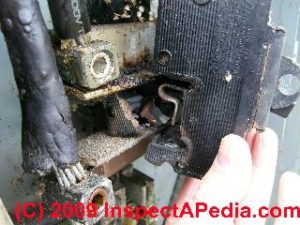Is your home safe from an electrical fire? An estimated 28,300 residential building electrical fires occurred each year between 2003 and 2005, resulting in 360 deaths, 1,000 injuries, and $995 million in losses, according to the United States Fire Administration.
Nearly half (47%) of these electrical fires, where equipment was involved, were started from wires overheating, causing their insulation to melt and ignite. Many of our homes are built with materials and methods of wiring that cannot sufficiently handle the heat build-up from the electrical demands of a typical household in the 21st Century. Heat-producing electrical equipment such as hair dryers, portable heaters and cooking appliances, use significantly more power than other electrical equipment. These devices may overload a circuit, especially one that is already reaching its maximum amperage allowance. Coupled with faulty circuit breakers and poorly wired outlets, this overload can cause the products to overheat and possibly to catch fire.
As a licensed electrician, I feel the need to inform our community about two major fire hazards I often come across in my work here in Nevada and Placer counties. The first hazard concerns a faulty electrical panel that was installed in many foothill homes and buildings in the 60’s and 70’s. Built by Zinsco, this panel was sold to Sylvania who marketed them under the Sylvania brand until finally closing down. These panels are known fire hazards. I believe homeowners need to be educated about this danger and how to prevent the possibility of property damage or injury by replacing the panels.
Tests have shown that the breakers on these panels do not perform properly under normal overload conditions. I have conducted my own tests on these panels and found that a Zinsco breaker does not trip as breakers are supposed to under a dead short condition. Breakers are thermally rated to turn off or “trip” in order to stop the flow of electricity in case of an emergency. When they do not trip, the heat buildup is a very real hazard to the homeowner.
A second fault of these panels is that the buss bars — the metal electrode that distributes current to the breakers — is so poorly designed that it melts due to this excess heat and compromises the connection between the breaker and buss bar. This malfunction can generate enough heat to cause a panel to go into a ‘meltdown’ condition. More information about these hazards is available by doing an online search for ‘Zinsco panel hazards.’
The other hazard I see far too often in homes and offices has to do with how wall outlets and switches are wired. The problem is in the use of push-in terminals. Marketed as a quick and efficient alternative to the standard method of installation, these push-in terminals allow someone to just strip a wire and push it into a hole on the backside of the electrical device. The wire is held in place by a spring-loaded piece of metal that keeps it from falling out of the receptacle. However, the wire can still turn in the hole and this can lead to a connection failure. A loose connection between the wire and the outlet or switch causes the electricity to arc and build up heat. I have repaired many outlets that have completely melted as a result of these loose connections. Again, an online search for ‘wire push-in outlet hazards’ will help illustrate many of these problems.
These two hazards are real, but the possible damage that can result is preventable. Such hazards tend to be hidden, and both the Zinsco panels and the push-in terminals can work or seem to work properly for years before showing signs of failure.
Buzzle.com lists electrical devices and wiring as number four on its list of the 10 most common hazards to know in preventing house fires. To be confident that your home is safe from an electrical fire, it is a worthwhile effort to have a thorough safety inspection performed on your entire electrical system.

